The street protests that erupted over the weekend in Cuba were the biggest at least since those a quarter century ago, when then-President Fidel Castro personally went into the streets to calm crowds of thousands furious over dire shortages that gripped the island following the collapse of the Soviet Union, which had long backed its socialist ally. So why have citizens taken to the streets right now?
What are protesters demanding?
Many expressed anger over long lines and shortages of food and medicines, as well as repeated electricity outages. Some demanded a faster pace of vaccination against COVID-19. But there were also calls for political change in a country governed by the Communist Party for some six decades. Some demonstrators chanted “Liberty!” “Down with the dictatorship!” and “Fatherland and life!” – a twist on the revolutionary slogan, “Fatherland or death!”
“It’s time for things to change. The situation is critical,” said Cristian Veliz, a 22-year-old construction worker.
What set off the protests?
Cuba’s government blames hardships on US sanctions that it calculates cost the island US $5.5 billion last year, though the figure is strongly disputed by its critics. It also claims the US government and its enemies in the US of using social media tools such as Twitter to send messages organizing the street protests.
Critics blame the government’s failure to shake up the eternally dismal state-run economy. While the government has created a series of broader openings for small-scale private businesses, they remain tightly controlled and limited. Cuba also has relied in recent years on tourism – income that has been devastated by the global pandemic – and on aid from ally Venezuela, which has declined along with Venezuela’s own economy.
A move this year to combine the country’s two sorts of currency into one also caused sharp inflation.
What was the role of social media?
Many protesters did learn of the demonstrations over social media platforms that have only recently become widespread in Cuba. They also used their phones to take images that were transmitted at home and abroad. The government responded by shutting down mobile data services by the state-run phone monopoly, effectively cutting off social media. Foreign Minister Bruno Rodriguez said officials detected the use of so-called “bots” based in the US to bombard Cuban phones with messages. Social media services began to become widespread only in 2018.
How did the government respond?
When protests broke out Sunday in the town of San Antonio de los Banos near Havana, President Miguel Diaz-Canel quickly went to speak with residents. He also broadcast a call for “revolutionaries” to take to the streets in support of the government. Police moved in and arrested dozens of protesters, sometimes violently. A heavy police presence has continued in areas such as the seafront Malecon boulevard, the capital building and the sprawling Plaza of the Revolution in Havana. Smaller protests also occurred on Monday, and officials reported at least one death.
In the days since the protests, government officials have appeared on television to analyze the situation, though they have not yet announced any new policies to confront the economic or other problems. Rodriguez, the foreign minister, has demanded the US accept its role in fomenting unrest.
How has the US responded?
President Joe Biden issued a statement of support for the protesters, saying, “We stand with the Cuban people and their clarion call for freedom and relief from the tragic grip of the pandemic and from the decades of repression and economic suffering to which they have been subjected by Cuba’s authoritarian regime.”
But the protests create a challenge for him, with political ramifications in Florida, a key electoral battleground that is home to many of the Cuban-Americans who left the island because of the Communist government there, as well as other people who fled from leftist regimes in Latin America. Republican lawmakers in particular are pushing for the administration to increase support for the demonstrators. So far, Biden has responded cautiously while officials continue with a review of US Cuba policy. So far he has not embraced the political and economic opening to Cuba carried out by the Obama administration – which was largely rolled back by Donald Trump

